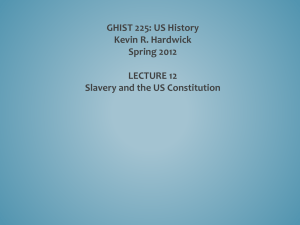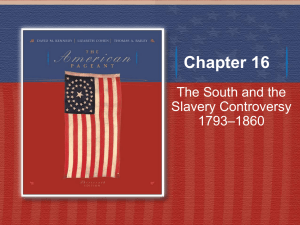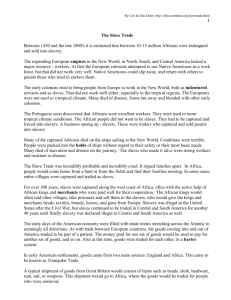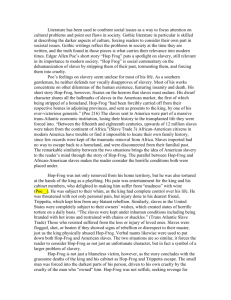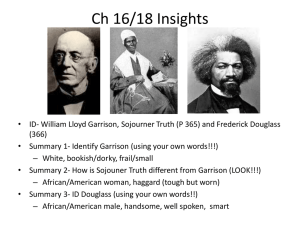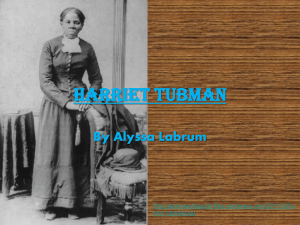Slavery_Stations_Activity
advertisement
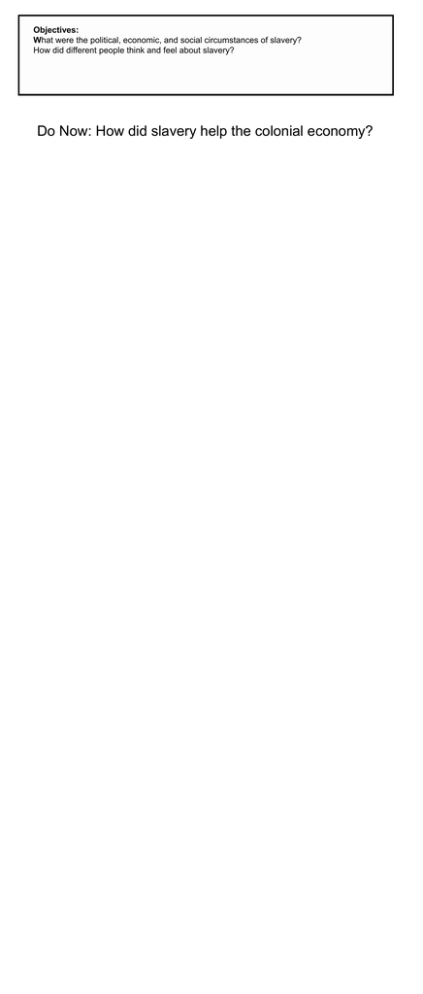
Objectives: What were the political, economic, and social circumstances of slavery? How did different people think and feel about slavery? Do Now: How did slavery help the colonial economy? Station Activity Directions 1. You will move in small groups to view the various documents. 2. Discuss the assigned question for each station. 3. Record your answer in your packet. Document 1A Indigenous African slavers from coastal regions would travel far into the interior to obtain slaves. They were generally better armed, having obtained guns from European merchants in trade for slaves. Slaves are yoked with a forked branch and fixed in place with an iron pin across the back of their necks. The slightest tug on the branch could choke the prisoner. Vocabulary indigenous African - from Africa slavers - people who captured other people to sell them into slavery yoked - tied up, shackled Original Source: "Voyage à la Côte Occidentale d'Afrique" by Louis Degrandpré, Paris 1801 Image and Text Source: http://africanhistory.about.com/od/slaveryimages/ig/Slavery-Images-Gallery/IndigenousSlavers001.htm Document 1B Source: "Captain Canot: Twenty Years of an African Slaver" by Brantz Mayer (ed.), New York 1854, cited from http://africanhistory.about.com/od/slaveryimages/ig/Slavery-Images-Gallery/SlaveInspection.htm Document 1C The Europeans built several castles and forts, along the coast of West Africa – Elmina, Cape Coast, etc.. These fortresses, otherwise known as 'factories', were the first permanent trading stations built by Europeans in Africa. Original Source: "Thirty Different Drafts of Guinea" by William Smith, London 1749 Image and Text source: http://africanhistory.about.com/od/slaveryimages/ig/Slavery-Images-Gallery/BritishTradingFort.htm Document 1D Prisoners could be held in slave sheds, or barracoons, for several months while awaiting the arrival of European merchants. Slaves are shown hobbled to roughly hewn logs (on left) or in stocks (on right). Slaves would be fastened to the roof supports by rope, attached around their necks or interweaved into their hair Vocabulary merchants - people who buy the slaves hobbled - tied to linked to Image Source: Source: "Boy Travelers on the Congo" by Thomas W Knox, New York 1871 Text and Image: http://africanhistory.about.com/od/slaveryimages/ig/Slavery-Images-Gallery/Prisoners.htm Document 2A http://blog.encyclopediavirginia.org/2011/12/05/rappahannock-bound/ Document 2B www.awesomestories.com Document 2C Image from the British Empire and Commonwealth Museum, as cited at http://jsench.wordpress.com/2011/05/26/the-middle-seat-is-not-themiddle-passage/ http://www.nps.gov/ethnography/aah/aaheritage/images/legShackles.jpg Document 2D http://staff.fcps.net/jwalker/Africa2.jpg Document 3A http://classrooms.cove.k12.or.us/Middle%20School/Teachers/HubbardR/Images/Social%20Studies% 20pics/U.S.%20History/Slavery/Atlantic%20slave%20trade.jpg Document 3B http://historyprofessorjoe.com/maps-2/slave-population-1770/ Sugar Plantation in the Caribbean http://cookit.e2bn.org/library/1246475291/plantion2.original.jpg Plantation in a southern colony http://home.comcast.net/~diazstudents/ColonialPlantation.jpg There were many Africans living in Colonial New York. In these years, they made up from 14 to 21 percent of the population. In the earliest colonial, enslaved New Yorkers cleared forest, built roads, supplied lumber, and did much farming. They were laborers and house servants. During English rule (1664-1781), a considerable number of New York's slaves became skilled artisans (blacksmiths, coopers, carpenters, seament, etc.), who earned money for their masters by being hired out as contract workers. They typical slave owners was a moderately wealthy, middle class, white male who had one or two slaves living in his attic or basement. Image from and text adapted from: http://projects.ilt.columbia.edu/Seneca/AfAMNYC/03bAfAmNYC.html Slave Auction http://hanovertavern.org/events/speaker-series-the-richmond-slave-trade




